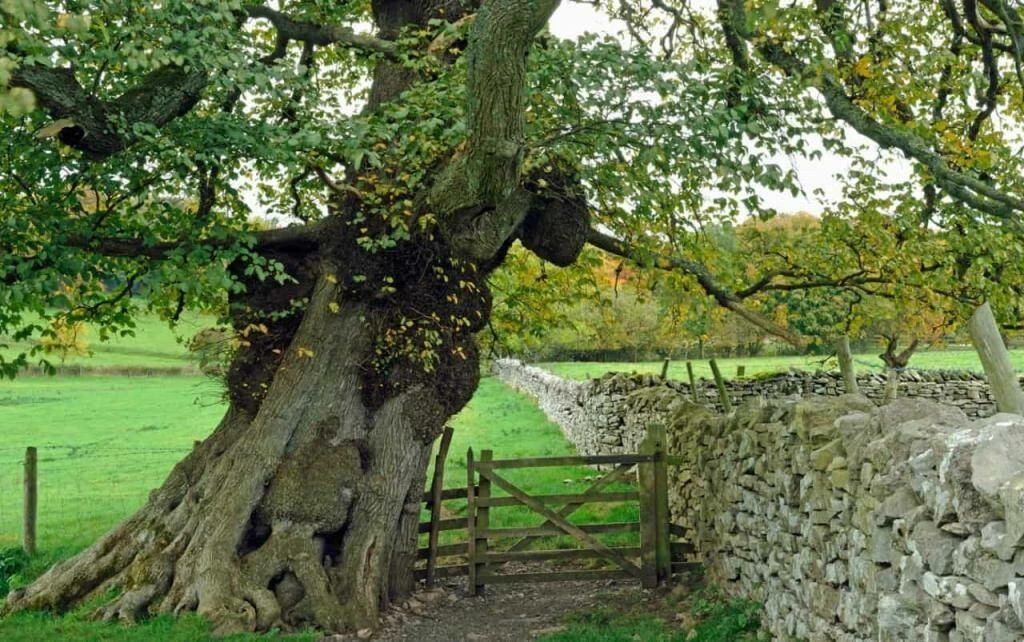In April of 1943, four young boys were searching for bird nests in a place called Hagley Woods near Stourbridge. This was a town in the area of the West Midlands. Legally, they were not supposed to be there, but they snuck into the area and went exploring. Eventually, they came across a large Wych elm. One of the boys decided to climb the tree and see if it contained any nests. At that moment he found a skull nestled in the tree. When someone wrote “Who put Bella in the Wych Elm?” around the area, the graffiti gave birth to a crime mystery that has endured nearly 80 years.

You May Also Like: The Oldest Tree in the World
Finding Bella in the Wych Elm
In the hollow center of the tree, the boy saw what he thought to be an animal skull. He reached down to pick it up and discovered to his horror that the object was actually a human skull. It was complete with teeth and patches of hair. He quickly dropped his dark discovery back into the tree’s hollow. The youngsters talked among themselves and decided that, since they were on the property illegally, they would keep the grisly find a secret. However, one of the boys apparently couldn’t keep the secret. Thus, his parents learned all about the skull, and they quickly contacted the local authorities.
Police went to investigate and pulled the skull from its hiding place. They dug further into the tree and came away with a full skeleton, minus one hand. Other discoveries included a wedding ring, one shoe, and remnants of cloth in the skull’s mouth. They dug around the base of the tree and later discovered the missing hand.
A forensic examination by a local professor revealed the fact that the skeleton was that of a female of about 35 years old. He estimated that she had been dead for approximately 18 months. Additionally, the body would not have fit into the hollow of the tree once rigor mortis had set in. Therefore, someone had most likely put her into the elm while she was still alive or soon after her death. The presence of the cloth (later determined to be a kind of taffeta) in the skull’s mouth indicated the strong possibility that the unknown woman had died from asphyxiation.
Theories of Bella’s Identity
Due to the war and a flurry of movement within England, the chances of identifying the skeleton were slim. She could have been someone from the local area. On the other hand, she may have been someone passing through on the way to a different place. The number of missing women of that era was enormous. However, the authorities did their best to find a name to go with the skeleton and to develop theories of how she got there in the first place.
You May Also Like: Who Killed Betsy Aardsma
Being wartime, one possibility they discussed was that the woman was involved in some kind of covert operation for the Germans. Had someone killed her for some reason because she was a spy? Or had she been a loyal Brit who had stumbled upon spy activity at the wrong place and time? This seemed an unlikely scenario, but it was a possible explanation.
A more sinister theory surfaced. Because one of the woman’s hands were in a different location from the rest of the body, some people theorized that the woman had died in some sort of human sacrifice. There is a folk belief that a “Hand of Glory” can give magical powers. Usually, the occultists would take the hand of an executed criminal and then dry it to use for occult purposes. Other authorities believed the much more plausible explanation that wild animals had moved the hand away from its original location with the body.
Who Put Bella in the Wych Elm?
The puzzle continued for several months and then got more mysterious. Starting in December, graffiti was painted (or put there by chalk) throughout the area. Initially, near the site of the body, someone had written, “Who put Luebbella down the wych-elm?” The police investigated the presence of a possible name for the skeleton. Luebbella would have been an unusual name. Unfortunately, this led nowhere. Later graffiti found on a stone monument near the site asked, “Who Put Bella In The Wych Elm?” This would be replicated in other areas, however, no one knew the identity of the person creating the graffiti.
Police wondered about the name. Did someone in the locale know the identity of the dead woman? Was she someone named “Bella”? Searches throughout the local area turned up no missing person report of someone with that name. Perhaps a spurned husband or lover put Bella in the wych elm.
Similar graffiti would turn up on walls and monuments for quite some time. Oddly, “wych” became “witch” in many cases, but eventually, the graffiti just stopped. Nobody knew why.
Over time, the legend of Bella and the Wych elm became local lore. Today, children still hear this story which ensures that the mystery of the unfortunate woman in the Wych elm will endure for many years to come.
Sources:
Stranger Dimensions
Brian Haughton.com